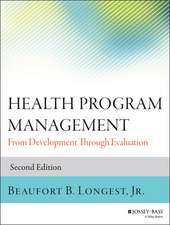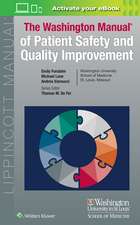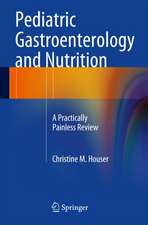Case Studies in Global School Health Promotion: From Research to Practice
Editat de Cheryl Vince Whitman, Carmen E. Aldingeren Limba Engleză Paperback – 29 oct 2010
Case examples from over two dozen countries (representing urban and rural areas in developing and developed nations) outline the strategies taken to implement HPS programs in individual schools, municipalities, and nations. For each program, case study authors explain the problems they tackled, their motivation and supports to respond creatively; and the barriers they faced. In the cases, authors describe the capacities and infrastructure they created and mechanisms for cooperation; as well as the personnel, financial, and time requirements involved. Case studies were drawn from the following regions:
- Africa
- The Americas
- Europe
- Eastern Mediterranean
- South and Southeast Asia
- Western Pacific.
| Toate formatele și edițiile | Preț | Express |
|---|---|---|
| Paperback (1) | 716.45 lei 6-8 săpt. | |
| Springer – 29 oct 2010 | 716.45 lei 6-8 săpt. | |
| Hardback (1) | 729.82 lei 6-8 săpt. | |
| Springer – 5 mai 2009 | 729.82 lei 6-8 săpt. |
Preț: 716.45 lei
Preț vechi: 754.15 lei
-5% Nou
Puncte Express: 1075
Preț estimativ în valută:
137.09€ • 142.86$ • 113.51£
137.09€ • 142.86$ • 113.51£
Carte tipărită la comandă
Livrare economică 03-17 aprilie
Preluare comenzi: 021 569.72.76
Specificații
ISBN-13: 9781441928276
ISBN-10: 1441928278
Pagini: 424
Ilustrații: XVII, 404 p.
Dimensiuni: 155 x 235 x 22 mm
Greutate: 0.59 kg
Ediția:Softcover reprint of hardcover 1st ed. 2009
Editura: Springer
Colecția Springer
Locul publicării:New York, NY, United States
ISBN-10: 1441928278
Pagini: 424
Ilustrații: XVII, 404 p.
Dimensiuni: 155 x 235 x 22 mm
Greutate: 0.59 kg
Ediția:Softcover reprint of hardcover 1st ed. 2009
Editura: Springer
Colecția Springer
Locul publicării:New York, NY, United States
Public țintă
Professional/practitionerCuprins
Section 1. Introduction and Overview of Findings.- Introduction and Background.- Framing Theories and Implementation Research.- Overview of Findings from Case Study Analysis.- Section 2. Case Studies.- Africa.- Kenya: Action-Oriented and Participatory Health Education in Primary Schools.- Mauritius: Health Promotion for Youth.- Nigeria: Health-Promoting Schools.- South Africa: Sapphire Road Primary.- The Americas.- Barbados: School Health Case Study.- Brazil: Addressing the Social Determinants of Health: The Experience of a Municipal School in Rio de Janeiro.- Canada: Case Study.- Nicaragua: The Social 'Treasure' of Participation.- United States of America: The Michigan Journey Toward Coordinated School Health.- Uruguay: Mainstreaming Health Promotion in Education Policies.- Europe .- Germany: Anschub.de—'Alliance for sustainable school health and education'.- Kosovo: A Health-Promoting Schools Approach to Reduce the Risks of Lead Poisoning and to Establish Cross-Ethnic Collaboration.- Poland: The Health-Promoting School National Certificate.- Scotland: Sustaining the Development of Health-Promoting Schools—The Experience of Scotland in the European Context.- Eastern Mediterranean.- Bahrain: National Comprehensive School Health Program, Health-Promoting Schools.- Oman: Health-Promoting Schools—Collaboration and Investment.- United Arab Emirates: Health-Promoting Schools—Strategies for Policy Change.- South and Southeast Asia.- China: Implementing Health-Promoting Schools inZhejiang Province, China.- Hong Kong: Health-Promoting Schools.- India: Implementing Health-Promoting Schools—HOPE Initiative.- Lao PDR: Strengthening the School Health Initiative.- Philippines: Supporting Health Promotion in Schools Through the Urbani School Health Kit.- Singapore:Health-Promoting Schools—The CHERISH Award.- Viet Nam.- Western Pacific.- Australia: The New South Wales School-Link Initiative.- Cook Islands: The 'Strengthening Project'
Recenzii
From the reviews:
"Using a case-based approach, this book describes the application of the health-promoting school (HPS) model to improve child health outcomes globally. … The audience is primarily graduate students in public health, education, allied health professions, and social sciences. A secondary audience is educators, policy makers, professionals and administrators in national governments, universities, nongovernmental agencies, schools, and civil society. The use of the case-based application is effective in covering the conceptual framework of HPS." (Carole A. Kenner, Doody’s Review Service, July, 2009)
"Using a case-based approach, this book describes the application of the health-promoting school (HPS) model to improve child health outcomes globally. … The audience is primarily graduate students in public health, education, allied health professions, and social sciences. A secondary audience is educators, policy makers, professionals and administrators in national governments, universities, nongovernmental agencies, schools, and civil society. The use of the case-based application is effective in covering the conceptual framework of HPS." (Carole A. Kenner, Doody’s Review Service, July, 2009)
Notă biografică
Cheryl Vince Whitman is a Senior Vice President and Division Director of the Health & Human Development Programs at Education Development Center.
Carmen Aldinger is a Project Director at Education Development Center (Newton, MA), where she manages the WHO Collaborating Center to Promote Health through Schools and Communities.
Carmen Aldinger is a Project Director at Education Development Center (Newton, MA), where she manages the WHO Collaborating Center to Promote Health through Schools and Communities.
Textul de pe ultima copertă
Case Studies in Global School Health Promotion
Cheryl Vince Whitman and Carmen Aldinger
A growing body of research identifies strong links between children’s health, social and educational outcomes; it also notes the reciprocal benefits of access to quality education on individual and family health status. In response to these findings, the World Health Organization developed the concept of the Health-Promoting School (HPS), a living catalyst for healthy lives, and for positive changes that students can take home and into the community. Case Studies in Global School Health Promotion provides readers with a theoretical and research base needed to understand the methods used in communities all over the world to put this captivating concept in place.
Case examples from over two dozen countries (representing urban and rural areas in developing and developed nations) outline the strategies taken to implement HPS programs in individual schools, municipalities, and nations. For each program, case study authors explain the problems they tackled, their motivation and supports to respond creatively; and the barriers they faced. In the cases, authors describe the capacities and infrastructure they created and mechanisms for cooperation; as well as the personnel, financial, and time requirements involved. Case studies were drawn from the following regions:
Cheryl Vince Whitman and Carmen Aldinger
A growing body of research identifies strong links between children’s health, social and educational outcomes; it also notes the reciprocal benefits of access to quality education on individual and family health status. In response to these findings, the World Health Organization developed the concept of the Health-Promoting School (HPS), a living catalyst for healthy lives, and for positive changes that students can take home and into the community. Case Studies in Global School Health Promotion provides readers with a theoretical and research base needed to understand the methods used in communities all over the world to put this captivating concept in place.
Case examples from over two dozen countries (representing urban and rural areas in developing and developed nations) outline the strategies taken to implement HPS programs in individual schools, municipalities, and nations. For each program, case study authors explain the problems they tackled, their motivation and supports to respond creatively; and the barriers they faced. In the cases, authors describe the capacities and infrastructure they created and mechanisms for cooperation; as well as the personnel, financial, and time requirements involved. Case studies were drawn from the following regions:
- Africa
- The Americas
- Europe
- Eastern Mediterranean
- South and Southeast Asia
- Western Pacific
Caracteristici
Focuses on new research on implementation Features 26 case studies of schools from around the world Based on WHO’s Global School Health Initiative Includes supplementary material: sn.pub/extras















